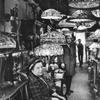Harvard Art Museums Appoint Sarah Laursen as New Curator of Chinese Art
- CAMBRIDGE, Massachusetts
- /
- January 29, 2020

Martha Tedeschi, the Elizabeth and John Moors Cabot Director of the Harvard Art Museums, has announced the appointment of Sarah Laursen as the new Alan J. Dworsky Associate Curator of Chinese Art, effective June 15, 2020.
Laursen is currently the Robert P. Youngman Curator of Asian Art at the Middlebury College Museum of Art, in Middlebury, Vermont; she is also assistant professor in the Department of History of Art and Architecture at Middlebury, where she leads courses for undergraduate students on Asian art and art history and museum studies. Her expertise is in the art of early medieval China, and she has extensive curatorial, teaching, and research experience encompassing topics ranging from ancient India and Korea to contemporary China. Laursen, who has substantial experience in the digital humanities, has incorporated digital tools such as API, ArcGIS StoryMaps, and photogrammetry into her exhibitions and teaching, seeking new ways to increase audience engagement, reveal patterns in art historical data, and improve accessibility for visitors with disabilities.
Since arriving at Middlebury in 2013, Laursen has organized a reinstallation of the college’s Robert F. Reiff Gallery of Asian Art and curated the exhibitions Shadow Lands: China through the Lens of Michael Cherney (2014), The Art of Storytelling: Five Tales from Asia, Then and Now (2015), and Perseverance: Japanese Tattoo Tradition in a Modern World (2016), as well as three forthcoming exhibitions that will open at Middlebury in 2020: Lost Luxuries: Ancient Chinese Gold; Hong Chun Zhang: Hair Story in Charcoal and Ink; and Into the Screen: Digital Art from teamLab. Her publications include contributions to The Art and Archaeology of Bodily Adornment: Studies from Central and East Asian Mortuary Contexts (Routledge, 2019); “Representation, Adaptation, and Preservation at the Frontiers in East Asian Art,” cowritten with Erin Schoneveld, for Verge: Studies in Global Asias (University of Minnesota Press, Spring 2018); “Art and Technology in a Chinese Gold Cicada Plaque,” cowritten with Donna Strahan, for Archives of Asian Art (Duke University Press, Spring 2014); and an essay on Xianbei gold in a forthcoming catalogue for the 2020 exhibition Xianbei Cemetery: Finds from Nomadic Cultures of the Inner Mongolian Steppe (Institute for the Study of the Ancient World).
Laursen received her B.A. in art history and East Asian studies from New York University in 2002 and her M.A. and Ph.D. from the Department of East Asian Languages and Civilizations at the University of Pennsylvania in 2005 and 2011, respectively. She was a postdoctoral fellow and later a visiting assistant professor at the Institute for the Study of the Ancient World at New York University in 2011–12, and she held teaching positions between 2007 and 2009 in the art history departments of the Tyler School of Art and Architecture at Temple University and Moore College of Art and Design, both in Philadelphia.
Laursen returns to Harvard after having been part of a significant project in the early 2000s to catalogue and digitize the Asian collections held in the Arthur M. Sackler Museum. That initiative, which received major support from the E. Rhodes and Leona B. Carpenter Foundation, gave her the opportunity to become well acquainted with the Chinese objects in the collection. The project contributed to the growth of online records available in the museums’ searchable collections tool, harvardartmuseums.org/collections, launched in May 2002.
In her role at the Harvard Art Museums, Laursen will join the Division of Asian and Mediterranean Art. She will primarily be responsible for the care, documentation, research, and presentation of the museums’ extraordinary collection of Chinese art, working closely with division colleagues and museum supporters to expand the collection. Laursen will also contribute to the care and presentation of the museums’ Korean art and Buddhist art collections. Additionally, she will collaborate with colleagues in the Division of Modern and Contemporary Art on the acquisition and presentation of contemporary works of Chinese art.
“We are delighted to welcome Sarah to our museums after an extensive search for a Chinese art curator who will truly thrive in this environment and working with this collection,” said director Martha Tedeschi. “Her talents and experience as a curator and teacher, along with her creativity and passion, will enliven and strengthen the Harvard Art Museums’ impact in the field of Chinese art history.”
In conjunction with crafting an ambitious exhibition, research, and publication program for the objects in her care, Laursen will collaborate with Harvard students and faculty to foster use of the collection for both undergraduate and graduate teaching. And as part of the museums’ own teaching and research objectives, she will also work closely with curatorial fellows and interns.
“I am humbled and excited to return to the Harvard Art Museums, which have shaped my experience of art history since my first visit in high school,” said Laursen. “While participating in the inventory project supported by the Carpenter Foundation, I had an opportunity to glimpse the breadth of the Chinese collection and scratch the surface of its storied past. Today, I am thrilled at the prospect of delving deeper into the study of these extraordinary objects and to find innovative ways to share them with the Harvard community, the greater Boston area, and the world.”
The Asian art collections at the Harvard Art Museums are considered among the finest in the United States and at a university museum anywhere in the world. The holdings encompass more than 17,000 works. The most renowned of Harvard’s nearly 6,500 Chinese objects include the ancient jades, ritual bronzes, and Buddhist sculptures bequeathed by Harvard alumnus Grenville L. Winthrop in 1943. Ceramics, tomb sculptures, later jades, and contemporary ink paintings are also strengths of the collection. Other notable areas of the Asian collections include Korean ceramics and paintings; Japanese manuscripts, paintings, and woodblock prints; and Buddhist art.




10270x400_c.jpg)

















100x100_c.jpg)